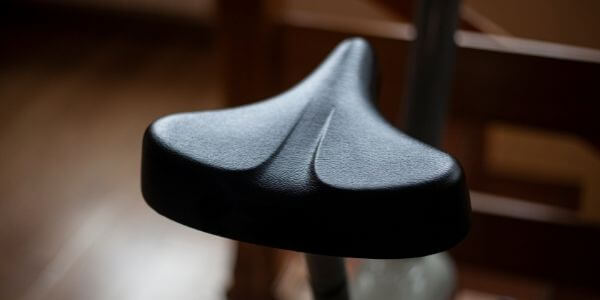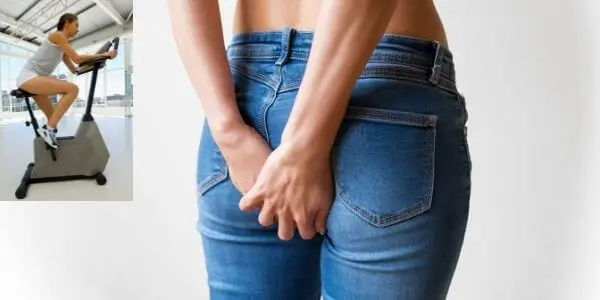Many people complain of butt soreness after riding their indoor bikes. In this article, we’ll explain the most frequent causes and solutions.
That’s the good news:
You don’t have to withstand that soreness, and you don’t have to power through uncomfortable workouts.
Read along to find out what you can do!
Table of Contents
Why Are Stationary Bike Seats so Uncomfortable?
Getting a sore bum after indoor cycling is normal, and there’s nothing wrong with your stationary bike. Even people who ride outdoor bikes get sore butts once in a while, especially after a long period of not riding.
Here’s what happens:
Stationary bike seats are narrow. Spin bikes have the narrowest seats of the bunch because they’re designed for speed. By contrast, recumbent bikes have wide and comfortably padded chairs.
Air bikes and upright bikes are somewhere in the middle.
So, when you’re sitting on that sort of seat, your pelvis takes on a lot of weight, particularly the two small bones at its bottom.
Besides, if you’re an endurance biker, aka pedaling for long periods, you’re more likely to experience pain in this area. Sitting down for longer on a narrow spin bike seat increases nerve compression and the amount of force on your pelvis.
Luckily, there are some things you can do to increase your bike riding comfort:
How to Make Stationary Bike Seat More Comfortable

Experiencing some soreness while riding your exercise bike may be okay, but the pain isn’t. So, if you’re feeling acute pain or if that initial soreness doesn’t go away after 3-4 sessions, here’s what you have to do:
1. Adjust Your Exercise Bike
Make sure your bike is adjusted well before you start your workout:
- Stand next to that stationary bike and place your hands on your hip bones. That’s the correct height for your seat.
- Adjust the seat depth by placing one elbow where the saddle begins. Next, move the seat until it’s one forearm away from the handlebars.
- Adjust the handlebars’ height, depth, and width so that your shoulders are down and your arms are shoulder-width apart.
Pro tip: Not all indoor bikes feature this array of adjustments. So, if you know you’re predisposed to saddle soreness, pick a stationary bike with multiple adjustments to ensure you’re sitting comfortably.
2. Sit Correctly
If you sit correctly on your saddle, you’ll minimize your post-workout soreness. Maintaining a correct position entails:
- Taking up the whole seat. Don’t place your bum in the narrow front part of the seat. Move a bit backward, so the bike’s padded part supports your butt.
- Sitting on the front part of your hips. Don’t sit down with your hips curled backward because your hip bones will take much of that pressure. Instead, focus on sitting on your “junk.” This anterior position keeps your hips open at a correct angle and aligned with your spine, so you’re alleviating pressure in your sacral area.
3. Jump Up
If you have a spin bike, you can sit up from the saddle during high-intensity parts of your workout. You can also do this on an air bike to give your bum a break.
Besides, changing your position from sitting to standing strengthens your legs and abs.
Pro tip: If you haven’t bought an exercise bike yet, check different products’ specifications to find one that supports a standing position. If your current stationary bike doesn’t allow you to stand up on it, consider taking breaks every ten minutes.
4. Padding
If you have saddle soreness, you can purchase separate seat pads (like these on Amazon). Pads increase comfort for beginners and help people with lumbar pain continue their workouts. Also, these pads work well because they’re plush and widen your bike seat.
Another solution is to purchase bike leggings with built-in pads as cyclists wear.
Pro tip: If you’re still reviewing stationary bikes for home use, analyze different models’ seat padding. Gel and foam cushions are the best options for people with exercise-induced soreness, sciatica, or hip pain.
5. Core Engagement
Keep your core engaged while you’re pedaling to relieve back pain. When you do this, your abs and lower back muscles take on more of the pressure you’re otherwise putting on your tailbone.
However, keeping a correct posture is critical.
You should:
- Sit with your back straight, not curled, and your shoulders level.
- Keep a slight bend in your elbows.
- Keep your shoulders away from your ears.
- Tighten your abs until it feels like you’re bringing your belly button inwards to your spine.
In Conclusion
While some exercise-induced soreness is normal, especially after longer workouts or a period of inactivity, pain isn’t normal. So, be sure to address your doctor/therapist if you’re experiencing any pain from riding your stationary bike.
With that in mind, you can alleviate normal soreness if you follow our tips above.
Here’s the “but”:
If you haven’t yet purchased an indoor bike or can’t get along with your current one, the solution is simple: get a more comfortable one.
First, make sure your new bike allows a broader range of adjustments to keep your body supported in a neutral position. Next, check that the seat is wide enough and features high-quality padding.
- How To Avoid Weight Loss Plateaus - July 9, 2024
- 5 Common Weight Loss Mistakes - July 9, 2024
- Walking vs Running: Weight Loss, Fat Loss, Life Span AND MORE - July 9, 2024

